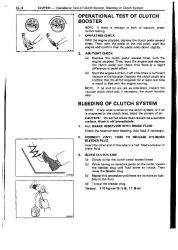Toyota DYNA 1984-1995 Workshop Repair & Service Manual
Catalog:
Model:
Complete digital repair shop manual contains service, maintenance, and troubleshooting information for the Toyota DYNA 1984-1995. Diagnostic and repair procedures are covered in great detail to repair, maintain, rebuild, refurbish or restore your Toyota DYNA like a professional mechanic in local service/repair workshop. This cost-effective quality manual is 100% complete and intact as should be without any missing pages. It is the same factory shop manual used by dealers that guaranteed to be fully functional to save your precious time.
This manual for 1984-1995 Toyota DYNA Truck is divided into different sections. Each section covers a specific component or system and, in addition to the standard service procedures, includes disassembling, inspecting, and assembling instructions. A table of contents is placed at the beginning of each section. Pages are easily found by category, and each page is expandable for great detail. It is in the cross-platform PDF document format so that it works like a charm on all kinds of devices. You do not need to be skilled with a computer to use the manual.
MAKE: Toyota
YEAR: 1984 1985 1986 1987 1988 1989 1990 1991 1992 1993 1994 1995
MODEL: DYNA Truck (U60-U90 Series)
1,012 pages, bookmarked, Searchable, Printable, high quality PDF
COVER
TABLE OF CONTENTS
Air Conditioning System
Body
Body Electrical System
Brake System
Clutch
Electrical Wiring Diagram
Front Axle and Suspension
Manual Transmittion
Propeller Shaft
Rear Axle and Suspension
Service Specifications
SST & SSM
Standard Bolt Tightening Torque
Steering
EXCERPT:
BRAKE SYSTEM - Checks and Adjustments
CHECKS AND ADJUSTMENTS
CHECK AND ADJUSTMENT OF BRAKE PEDAL
1. CHECK THAT PEDAL HEIGHT IS CORRECT
Pedal height:
Regular cab 200.0 mm (7.874 in.)
Wide cab 198.5 mm (7.815 in.)
If incorrect, adjust the pedal height.
2. IF NECESSARY, ADJUST PEDAL HEIGHT
(a) Sufficiently loosen the stop light switch.
(b) Sufficiently loosen the pedal stopper.
(c) Adjust the pedal height by turning the pedal push rod.
(d) Lock the pedal stopper at the position where it lightly strikes the pedal.
(e) Return the stop light switch until its body lightly contacts the idler arm.
(f) After adjusting the pedal height, check and adjust the pedal freeplay.
3. CHECK THAT PEDAL FREEPLAY IS CORRECT
(a) Stop the engine and depress the brake pedal several times until there is no more vacuum left in the booster.
(b) Push in the pedal until the beginning of resistance is felt. Measure the distance, as shown.
Pedal freeplay: 3- 6 mm (0.12- 0.24 in.)
NOTE: The pedal freeplay is the amount of the stroke until the booster air valve is moved by the pedal push rod.
If incorrect, adjust the pedal freeplay.
4. IF NECESSARY, ADJUST PEDAL FREEPLAY
(a) Adjust the pedal freeplay by t1:1rning the pedal push rod.
(b) Start the engine and confirm that pedal freeplay exists.
(c) After adjusting the pedal freeplay, check the pedal height.
5. CHECK THAT PEDAL RESERVE DISTANCE IS CORRECT
Depress the pedal and measure the pedal reserve distance, as shown.
Pedal reserve distance from floor panel at 50 kg (11 0.2 lb, 490 N): More than 60 mm (2.36 in.)
If incorrect, troubleshoot the brake system.
OPERATIONAL TEST OF BRAKE BOOSTER
NOTE: If there is leakage or lack of vacuum, repair before testing.
1. OPERATING CHECK
(a) Depress the brake pedal several times with the engine off, and check that there is no change in the pedal reserve distance.
(b) Depress the brake pedal and start the engine. If the pedal goes down slightly, operation is normal.
2. AIR TIGHTNESS
(a) Start the engine and stop it after one or two minutes Depress the brake pedal several times slowly. If the
pedal goes far down the first time, but gradually rises after the second or third time, the booster is air tight
(b) Depress the brake pedal while the engine is running and stop it with the pedal depressed. If there is no change in pedal reserve travel after holding the pedal for thirty seconds, the booster is air tight.
BLEEDING OF BRAKE SYSTEM
NOTE: If any work is done on the brake system or if air is suspected in the brake lines, bleed the system of air.
CAUTION: Do not let brake fluid remain on a painted surface. Wash it off immediately.
1. FILL BRAKE RESERVOIRS WITH BRAKE FLUID
Check the reservoir after bleeding each wheel. Add fluid, if necessary.
2. CONNECT VINYL TUBE TO WHEEL CYLINDER
BLEEDER PLUG
Insert other end of the tube in a half-filled container of brake fluid.
NOTE: Begin air bleeding from the wheel cylinder with the longest hydraulic line.
3. BLEED BRAKE LINE
(a) Slowly pump the brake pedal several times.
(b) While having an assistant press on the pedal, loose the bleeder plug until fluid starts to runout. Then close the bleeder plug.
(c) Repeat this procedure until there are no more air bubbles in the fluid.
...
Toyota DYNA 1984-1995 Workshop Repair & Service Manual





